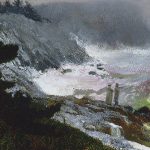Crystal Bridges Museum of American Art unveiled their latest exhibits, Warhol’s Nature and Jamie Wyeth, which will be displayed alongside one another through October 5th. The two artists became close friends later in life and had a profound impact on each other’s work.
WARHOL’S NATURE
When most of us think of Andy Warhol, fright wigs and color-saturated, overblown screen prints of movie stars probably come to mind. And don’t forget the canvas filled with repeating images of soup cans. But Crystal Bridges Museum of American Art Curator Chad Alligood, has put together an exhibit of the late artist’s work that is unmatched in its thematic focus. In fact, he is the first curator to look into Warhol’s appreciation of nature and pull this kind of exhibition together anywhere.
“Warhol’s relationship to nature was always a little uncomfortable.” explains Alligood, “We’re excited to present the untold story, uncovering layers of Pop to reveal an artist deeply interested in cultivating and preserving the nature outside and the nature within us all.”
The exhibit not only showcases final works from the 1960s to the 1980s, it also includes sketches and compositional photos of the planning behind some of Warhol’s most iconic work, and items from his personal collections that speak to his love of animals and nature – like the taxidermy Great Dane, “Cecil”, that stood in the entry of Warhol’s famous collaborative workspace, The Factory.
The works presented in Warhol’s Nature were sourced primarily from the largest single-artist museum in the world, The Andy Warhol Museum in Pittsburgh, Pennsylvania. Well-known artworks on display in the exhibition include Warhol’s Self-Portrait in his infamous fright wig overlaid with camouflage; the iconic and pivotal Flowers series of the 1960s; Silver Clouds, an interactive installation; and 10 images from the Endangered Species series.
JAMIE WYETH
Concurrently on display in an adjacent gallery is Jamie Wyeth, an exhibition organized by the Museum of Fine Arts, Boston that introduces attendees to six decades of Wyeth’s work – beginning with drawings collected by his mother when he was only five years old, and evolving through recurring themes inspired by the people, places and objects that populate his world. The exhibition displays paintings, works on paper, illustrations and objects in a range of “combined mediums” – Wyeth’s preferred term for the distinctive technique he brings to many of his compositions.
The third generation in a family of artists that includes his grandfather, Newell Convers “N.C.” Wyeth; his father, Andrew Wyeth; and his aunt, Carolyn Wyeth; Jamie Wyeth has blazed his own unique path. He was encouraged to pursue art at a young age, but never attended art school. Instead, he left school at the age of 11 and received instruction at home from his aunt, a surrealist painter, with critical guidance from his father.
If it’s a surprise to learn that Warhol was influenced by nature, there is no question of the fact when viewing Wyeth’s works. Surrounded as he was by pastoral settings in his family home in Pennsylvania and later in Maine, Wyeth communicates his love of light and natural elements so easily that a viewer can practically smell the field grass while gazing on a painting of a bale of hay.
But while we might assume that the two artists are miles apart in their subject matter and creative processes, there are actually more commonalities between Warhol and Wyeth than you might see on the surface; a commonality that prompted the combined exhibitions.
“Presenting these exhibitions concurrently provides viewers the chance to experience art by two contemporaries with distinct artistic styles and different worldviews. The exhibitions explore the life and career of Warhol and Wyeth, and uncover a fascinating and lesser-known friendship between the artists,” says Rod Bigelow, Crystal Bridges Executive Director.
Jamie Wyeth is organized with the artist’s earliest work in the first gallery space, and the latest work at the end. Three distinct geographic regions are represented in the middle gallery spaces, lending import to the themes and subjects of those places where Wyeth was working at different times of his life.
In addition to his powerful representations of the natural world, Wyeth’ portraits are testaments to Wyeth’s remarkable power of observation and ability to capture a person’s humanity with paint. His Portrait of Shorty, painted in 1963 when he was seventeen, reflects the culmination of his early years as an apprentice within his own family circle, while his formative years during the 1960s and ’70s produced paintings such as his Portrait of John F. Kennedy, painted when he was twenty-one. Wyeth exchanged portraits with Andy Warhol in 1976, bringing all his tools and skills to bear on Warhol’s every pore, blemish, and strand of his carefully styled wig in Portrait of Andy Warhol.
Warhol’s Nature and Jamie Wyeth are on view July 25 through October 5, 2015. Admission is $8 for a combined ticket and as always, temporary exhibitions are free for museum members and youth ages 18 and under.








